Dell XPS 15 (2021) Review
A luxurious 15-inch laptop
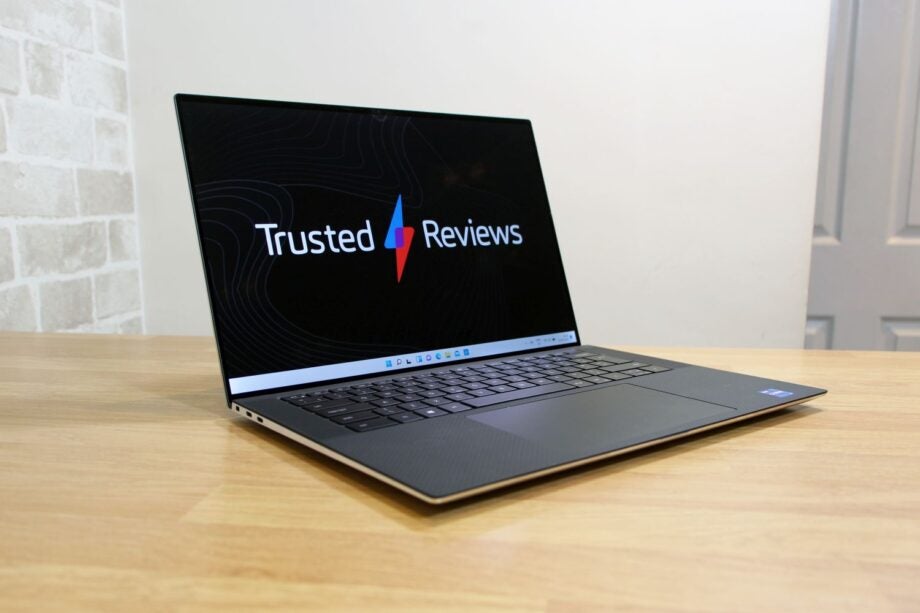

Verdict
Dell’s latest XPS 15 impresses in most of the key departments. It looks and feels fantastic, and offers plenty of processing power. Its keyboard is superb and its display is bold and crisp. If you’re after a stylish and slim work laptop then the Dell XPS 15 (2021) is well worth consideration – although be aware that you’ll find better colour accuracy and longevity elsewhere.
Pros
- Sleek, sturdy and impressive design
- Lots of processing power
- High-quality keyboard
- Vivid, bright and high-resolution display
Cons
- Some colour accuracy issues
- Middling battery life
- Some missing ports
- Underwhelming graphics core
Availability
- UKRRP: £2248
- USARRP: $2249
- EuropeRRP: €2298
Key Features
- Good-looking, sturdy designA combination of aluminium and carbon fibre results in machine that not only looks good, but one that displays fantastic build quality. Relatively light and slim dimensions make it one of the most portable 15.6in machines around, too
- A bold 16:10 screenPresenting generous vertical space, the 3840 x 2400 resolution results in lots of pixels too. Dell’s IPS touchscreen is bright and bold, with plenty of contrast. But colour accuracy could be better
- A powerful Intel processorThe Core i7-11800H has eight cores and impressive speeds, so it’s able to handle virtually any creative task. The Dell also has lots of fast memory and a capacious 1TB SSD alongside dedicated Nvidia graphics
Introduction
Dell XPS machines are more luxurious than most productivity portables, and this continues with the latest XPS 15. It’s a sleek laptop that is likely to look better than any other in the office.
Matching the attractive exterior is powerful hardware and impressive display options, too.
However, XPS machines are rarely the most affordable devices, and that remains true here. This model comes with a Core i7 processor and a 500-nit display with a huge 3840 x 2400 resolution, setting you back £2248 in the UK, $2249 in the US and €2298 in Europe.
Still, those prices don’t look terrible when compared to other high-end productivity machines. The smaller Lenovo ThinkPad X1 Titanium Yoga is a 13.5in convertible rig, with equivalent models costing £2227 / $1766 / €2887. If you want something creative, the Acer ConceptD Ezel 7 comes with a 4K touchscreen on an innovative hinge alongside Core i7 processing for £2799 / $3699 / €3215.
Design and Keyboard
- Good-looking and sturdy aluminium and carbon-fibre chassis
- A superb keyboard with a great typing action
- Includes Thunderbolt 4, but other connectivity options are absent
The Dell XPS 15 is still one of the best-looking laptops on the market thanks to the familiar combination of aluminium and carbon fibre, and the machine is available in two colour schemes: the silver and black model reviewed here, and a white version.
Not a great deal has changed from the previous iteration, but this isn’t necessarily a bad thing. The XPS looks fantastic, and the laptop has been refined with even slimmer display bezels and diamond-cut edges. Indeed, those edges are the only issue – they look great, but they’re sharp.
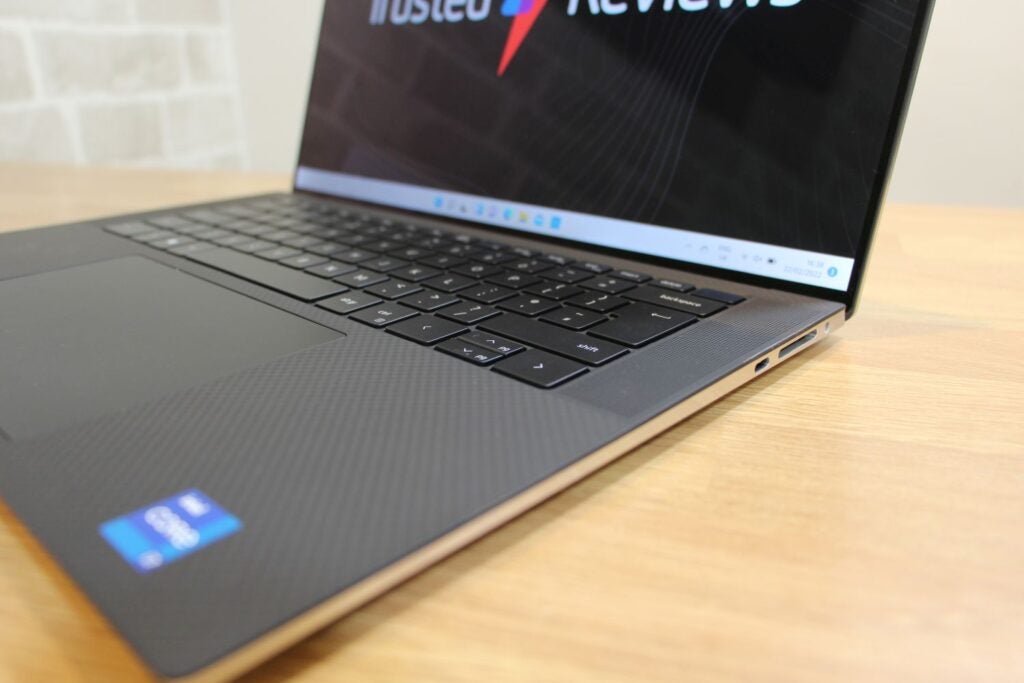
Note, too, that the XPS won’t bloat your backpack. It weighs between 1.8kg and 1.96kg, depending on the specification, and it’s 18mm thick. Those good figures easily undercut the Acer, although the convertible Lenovo is far lighter. The Dell’s build quality is impeccable, too – this sturdy machine won’t balk at life on the road.
Dell’s increasingly svelte designs mean that you lose out on some physical connectivity. The left-hand edge is home to two Thunderbolt 4 ports, with the right-hand side including a USB 3.2 Gen 2 port that supports DisplayPort and power delivery alongside a headphone jack and an SD card reader.
For ports, that’s it – there are no full-size USB ports, no HDMI, and no Ethernet. Dell includes full-size USB and HDMI adapters in the box, but no wired internet adapter – and adapters are rarely an elegant solution. The slim Lenovo suffers similarly, while the chunky Acer offers better connectivity.
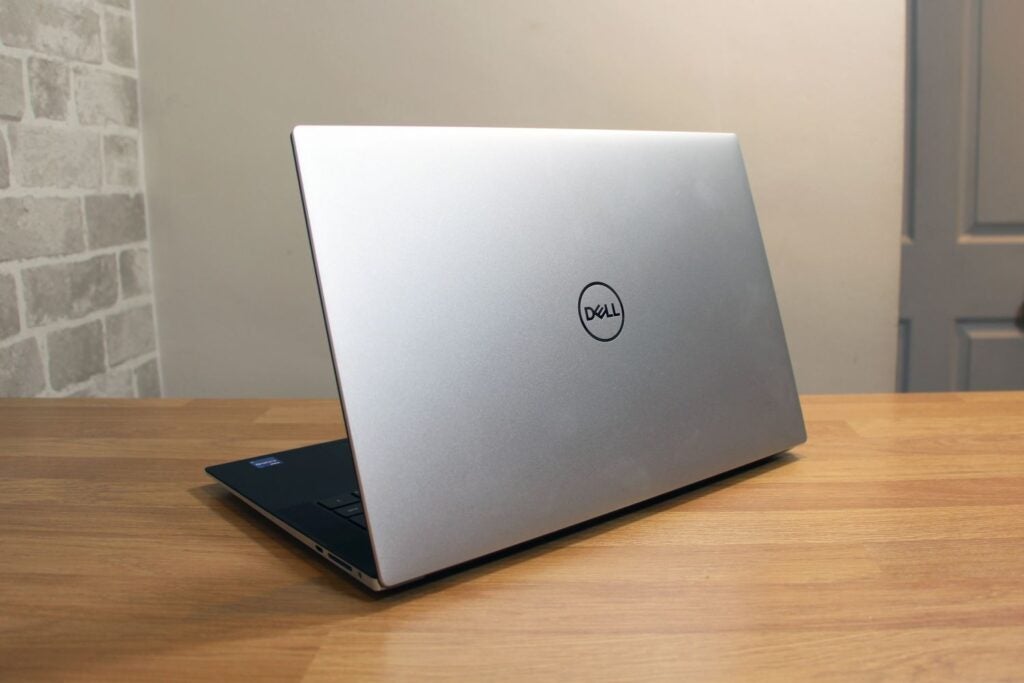
Above the display is a 720p webcam with Windows Hello support, and the power button includes a fingerprint reader. The audio setup is excellent, too, with two 2.5W woofers and two 1.5W tweeters. They fire up from either side of the keyboard delivering fantastic quality, clarity and volume – they’re among the best laptop speakers on the market.
As ever, Dell’s robust machine includes a market-leading keyboard. Its buttons are large, the base is sturdy, and it offers a crisp, consistent action with decent travel. The only downside is the lack of a numberpad. The trackpad is huge, too, with comfortable buttons and full gesture support.
Screen
- A huge resolution and 16:10 aspect ratio improve versatility
- Fantastic contrast and bright, bold colours make work tasks look great
- Colour accuracy isn’t quite there – opt for the OLED instead
The Dell XPS 15 has a 15.6in display with a 16:10 aspect ratio. That means you get more vertical space than conventional 16:9 panels, making it easier to work in web browsers and Office tools.
Entry-level XPS models come with 500-nit IPS panels with a 1920 x 1200 resolution, and the same technology resides in the 3840 x 2400 unit reviewed here. The third option is an OLED display with a 3456 x 2160 resolution. You lose a few pixels, and its brightness peaks at 400 nits, but its OLED hardware means you get perfect contrast and flawless blacks.
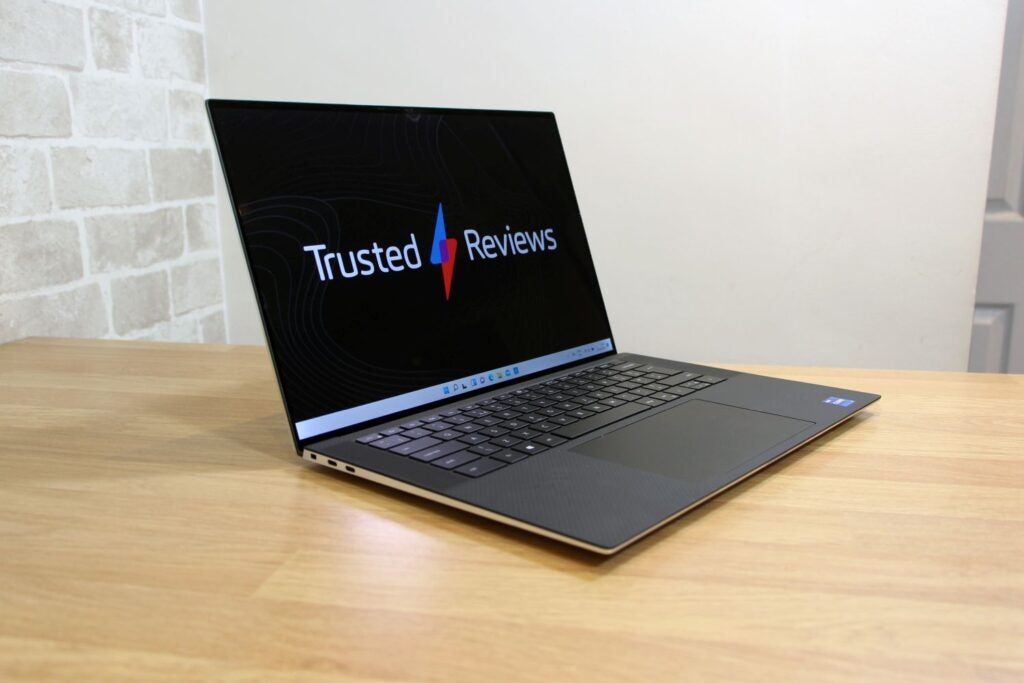
The two higher-resolution screens use Gorilla Glass 6 and support touch control – the lower-resolution model does not.
The non-OLED model reviewed has a contrast level of 1758:1, which is fantastic for an IPS panel, and the black point of 0.26 nits is similarly great. Those results help the XPS produce incredible vibrancy and depth. The display also hit a peak brightness level of 457 nits, which is easily good enough for any situation, even if it’s a little short of Dell’s quoted 500-nit figure.
The screen renders 99.9% of the sRGB colour gamut, 99.5% of the Adobe RGB space and 90.7% of DCI-P3/HDR, with higher volume levels. This equates to extremely vibrant colours, and those results are all good enough to enable working in each colour space.
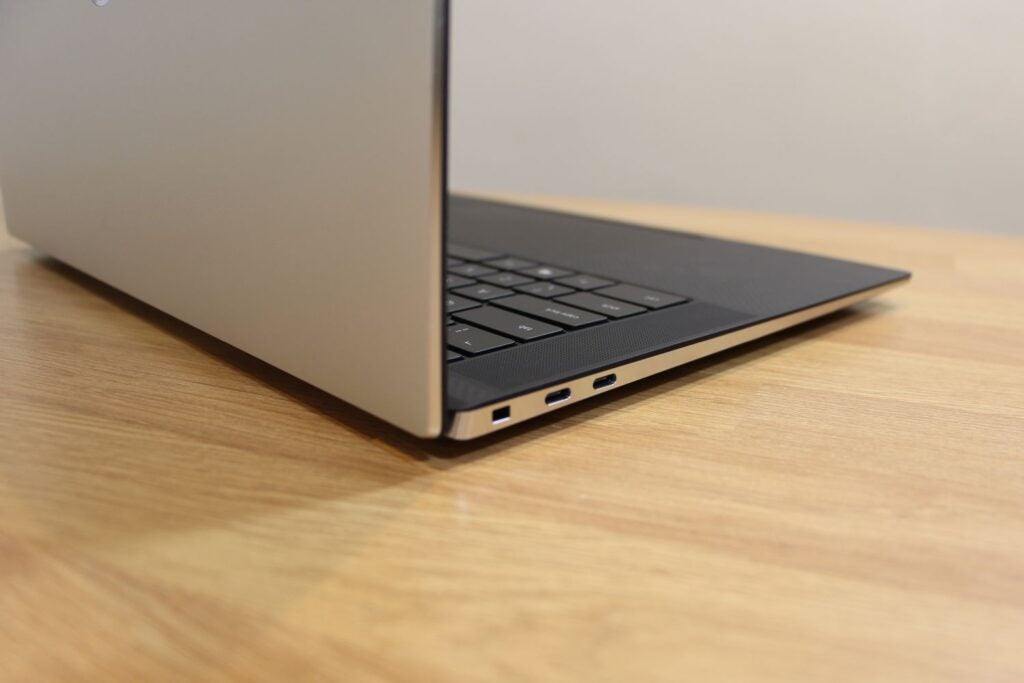
Sadly, that vibrant output is undermined by the panel’s Delta E level of 4.36. It’s an average result that doesn’t hinder everyday work tasks, but won’t suffice for creative workloads that demand near-perfect accuracy. The PremierColor app supports calibration if you have the right colorimeter, but even that only improved the Delta E to a middling 3.56.
This Dell panel is vibrant, punchy and crisp, and it will make most work and computing tasks look fantastic. But it isn’t as good as the screen on the pricier Acer, and its lack of colour accuracy precludes it from excelling in the most demanding colour-sensitive tasks. The alternative OLED panel is better for colour accuracy, depth and contrast.
Performance
- The Intel Core i7-11800H is an excellent chip for any creative task
- Dell’s machine stays cool and quiet, no matter the workload
- The Nvidia GPU is a bonus, but it isn’t particularly powerful
Intel’s Core i7-11800H is an eight-core CPU with a peak speed of 4.6GHz, and it’s a great all-rounder. This rig has 32GB of dual-channel memory, a 1TB SSD, and connectivity from dual-band Wi-Fi 6 and Bluetooth 5.1. Dell’s laptop also has an Nvidia GeForce RTX 3050 Ti graphics core – a mid-range unit with 4GB of dedicated memory and a modest 45W peak power limit.
This laptop is an impressive performer. Its single- and multi-core Geekbench results of 1539 and 8935 are among the best I’ve seen from the i7-11800H, and better than the AMD Ryzen 7 5800H that’s often used in productivity portables. Not surprisingly, the Dell has a convincing lead over the 10th-Gen hardware inside the Acer, and it’s miles ahead of the Lenovo’s low-power Core i7 chip.
| Dell XPS 15 2021 | MacBook Pro 2021 | Acer ConceptD Ezel 7 | |
| CPU | Intel Core i7-11800H | Apple M1 Pro | Intel Core i7-10875H |
| Geekbench 5 Single Core | 1539 | 1745 | 1266 |
| Geekbench 5 Multi Core | 8935 | 12,520 | 7624 |
The Dell never struggles with multi-tasking, lots of office apps and a bevy of browser tabs open at one time, and it has the grunt to handle photo-editing and 1080p video workloads; it will run anything short of the toughest 4K tasks and high-end creative software. This laptop is a good thermal performer, too: no matter what I threw at the Dell, fan noise was kept to a minimum. The exterior did become warm in tough work scenarios, but never reached uncomfortably hot temperatures.
You’ll get greater power if you spend more on a laptop with an Intel Core i9 or AMD Ryzen 9 processor – and those devices tend to be larger and heavier. If you’re happy to wait, Dell will almost certainly update the XPS with Intel’s faster 12th-Gen processors.
Switch over to the GPU and you’ll find that the Dell is more limited. In 3DMark’s Time Spy test, the Dell’s RTX 3050 Ti scored 4596. That’s better than most integrated graphics cores, but more than 1500 points behind the Acer’s older RTX 2070. It’s even further behind modern GPUs, and around 1000 points off this core’s maximum speed.
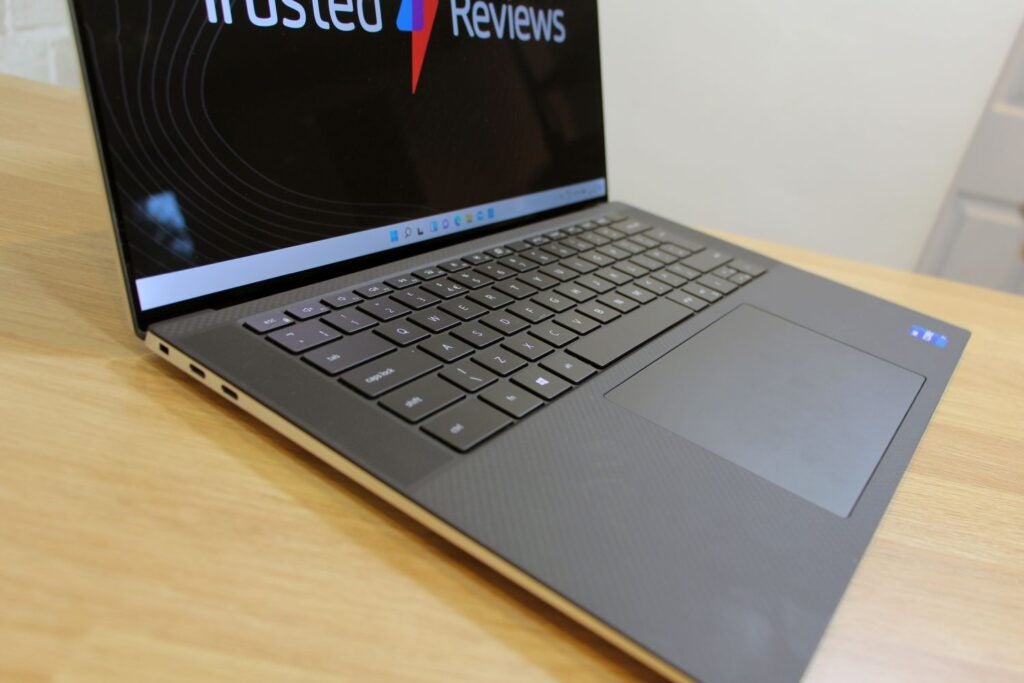
The RTX 3050 Ti does have enough graphical power to handle content-creation apps, but it will struggle with high-end tasks. If you want to play games, expect to run eSports titles at 1080p and single-player games with reduced graphics settings. It’s no match for a proper gaming laptop.
Also bear in mind that the display has a 60Hz refresh rate, which is fine for casual gameplay but a long way short of the speed you’ll see from a proper gaming panel.
Battery Life
- You’ll get through a working day unless you really push the hardware
- Dell’s laptop doesn’t excel here; it’s reasonable, but nothing better
When running PCMark 10’s modern office benchmark with the display at 150 nits, the Dell XPS 15 lasted for 9hrs 4mins; and 10hrs 37mins in a 150-nit video benchmark. If you use this machine to handle everyday workloads without the display at full brightness, you’ll easily get through your working day.
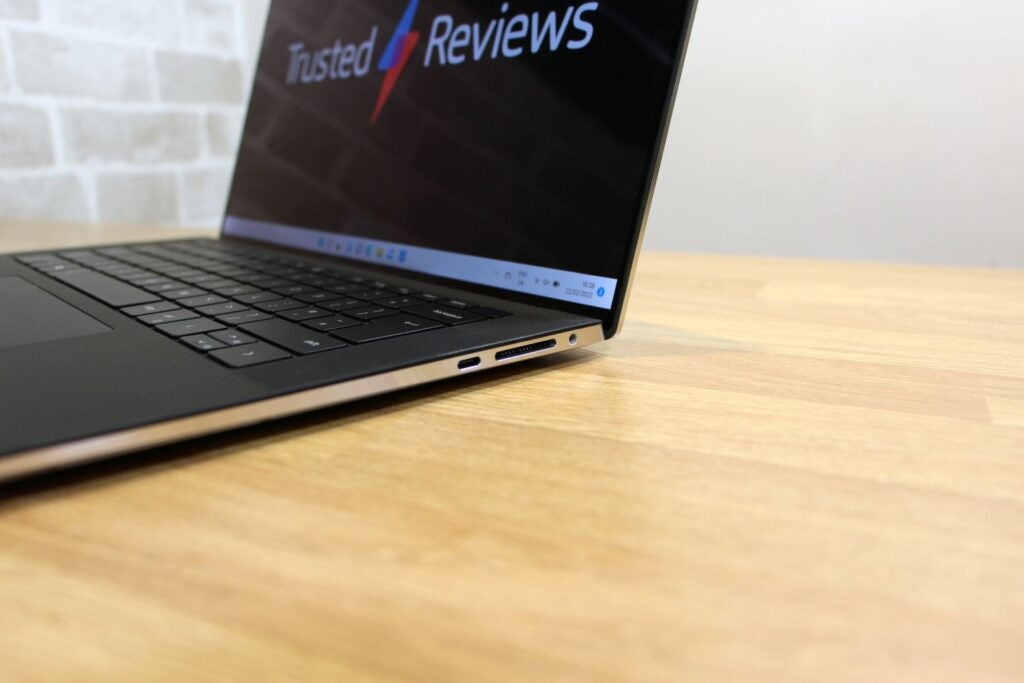
That’s a reasonable start, but upping the screen brightness saw its endurance decline to 6hrs 33mins. If you want to make use of the screen or push the processor, you’ll need to plug in this laptop before the end of the day. If you add the graphics core to the mix, expect the Dell to run out of juice after three hours.
These results aren’t awful; they’re normal for a productivity laptop – Dell doesn’t go beyond the rest of the market here.
Latest deals
Should you buy it?
You want a good-looking, light and powerful work laptop:
Dell’s design, processor and keyboard are all superb. Combine that with the bold panel and you’ve got a machine that can tackle almost every work task with style.
You need perfect colour accuracy, better battery life or a powerful graphics core:
The Dell’s IPS displays have some colour accuracy issues. And while the battery and graphics core are fine, they’re easily bettered elsewhere.
Final Thoughts
The Dell XPS 15 remains one of the best-looking and strongest work laptops you can buy. It doesn’t just look good, either: it’s fast, offers good ergonomics, and its display is punchy. It’s an ideal choice for most working situations, but we’d advise you look elsewhere if you need perfect colours or exceptional battery life.
How we test
Every laptop we review goes through a series of uniform checks designed to gauge key things including build quality, performance, screen quality and battery life.
These include formal synthetic benchmarks and scripted tests, plus a series of real-world checks, such as how well it runs the most frequently used apps.
We also make sure to use every laptop we review as our primary device to ensure our review is as accurate as possible.
Used the laptop for a week
Used Geekbench 5, PCMark 10 and 3Dmark to test performance
Used a colorimeter to test the display
Used PCMark 10 to test the battery life
FAQs
The Dell XPS 15 can be upgraded with an eight-core Intel Core i9-11900H processor, and it can also be configured with 16GB or 64GB of memory alongside 512GB and 2TB SSDs.
Trusted Reviews test data
Full specs
Jargon buster
OLED
Organic Light Emitting Diode is panel technology that allows each individual pixel to produce light rather than relying on a backlight. This enables the screen to accurately display blacks by turning off the pixel, resulting in improved contrast compared to conventional LCD panels.Nits
The brightness level of a display. 300 nits is regarded as the minimum target for high-end screens.








